Use Cases and Object Oriented Programming Approach: A Report
VerifiedAdded on 2020/04/21
|12
|2002
|148
Report
AI Summary
This report delves into the crucial relationship between Use Cases and Object-Oriented Programming (OOP). It explains that while Use Cases aren't inherently part of OOP, they are essential in the analysis phase of software development. The report provides a detailed explanation of both Use Cases and OOP concepts, highlighting their individual roles. It then illustrates their combined use through a practical example: an Address Book application scenario. The report breaks down the application's components, including the AddressBook, Person objects, and GUI elements. It also describes how Use Cases like 'Add a Person,' 'Edit a Person,' and 'Save Address Book' interact with these objects. Through this example, the report emphasizes how Use Cases help developers understand system goals and build robust applications. The report concludes that Use Cases are a vital component of the OOP approach, providing a clear framework for understanding object interactions and system functionality. The provided diagrams illustrate the relationships between the user, system, and objects involved in the Address Book application.
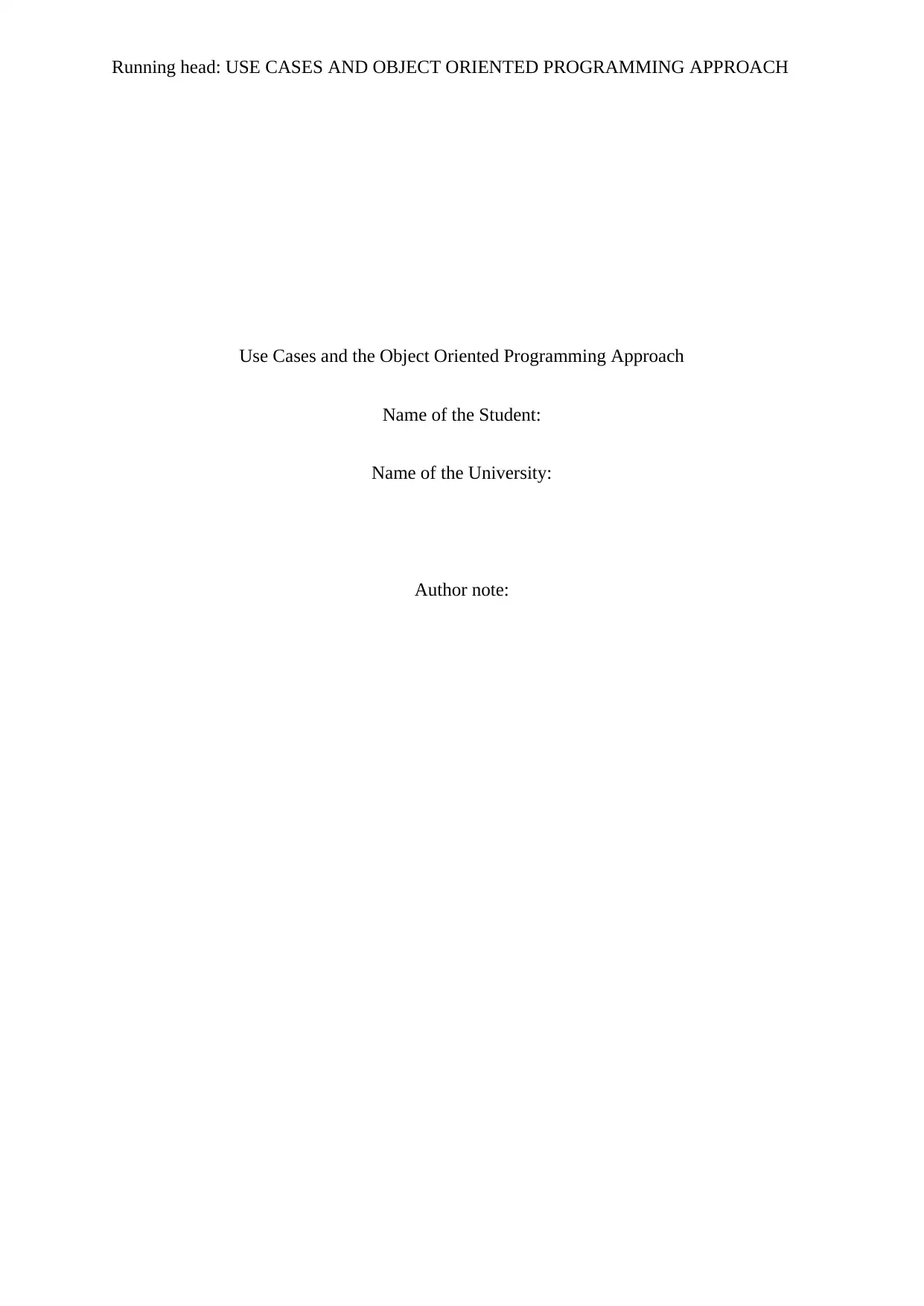
Running head: USE CASES AND OBJECT ORIENTED PROGRAMMING APPROACH
Use Cases and the Object Oriented Programming Approach
Name of the Student:
Name of the University:
Author note:
Use Cases and the Object Oriented Programming Approach
Name of the Student:
Name of the University:
Author note:
Paraphrase This Document
Need a fresh take? Get an instant paraphrase of this document with our AI Paraphraser
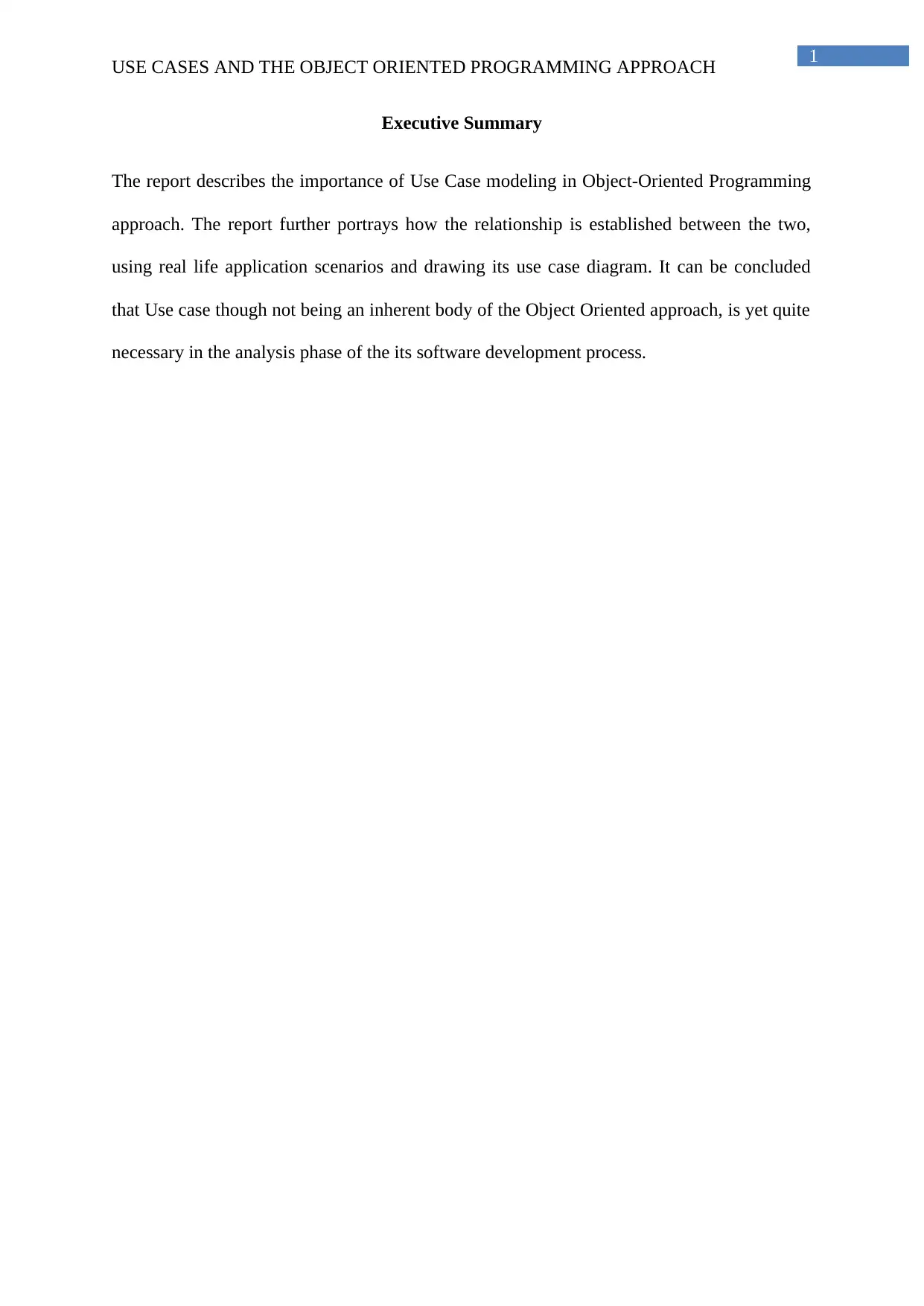
1
USE CASES AND THE OBJECT ORIENTED PROGRAMMING APPROACH
Executive Summary
The report describes the importance of Use Case modeling in Object-Oriented Programming
approach. The report further portrays how the relationship is established between the two,
using real life application scenarios and drawing its use case diagram. It can be concluded
that Use case though not being an inherent body of the Object Oriented approach, is yet quite
necessary in the analysis phase of the its software development process.
USE CASES AND THE OBJECT ORIENTED PROGRAMMING APPROACH
Executive Summary
The report describes the importance of Use Case modeling in Object-Oriented Programming
approach. The report further portrays how the relationship is established between the two,
using real life application scenarios and drawing its use case diagram. It can be concluded
that Use case though not being an inherent body of the Object Oriented approach, is yet quite
necessary in the analysis phase of the its software development process.
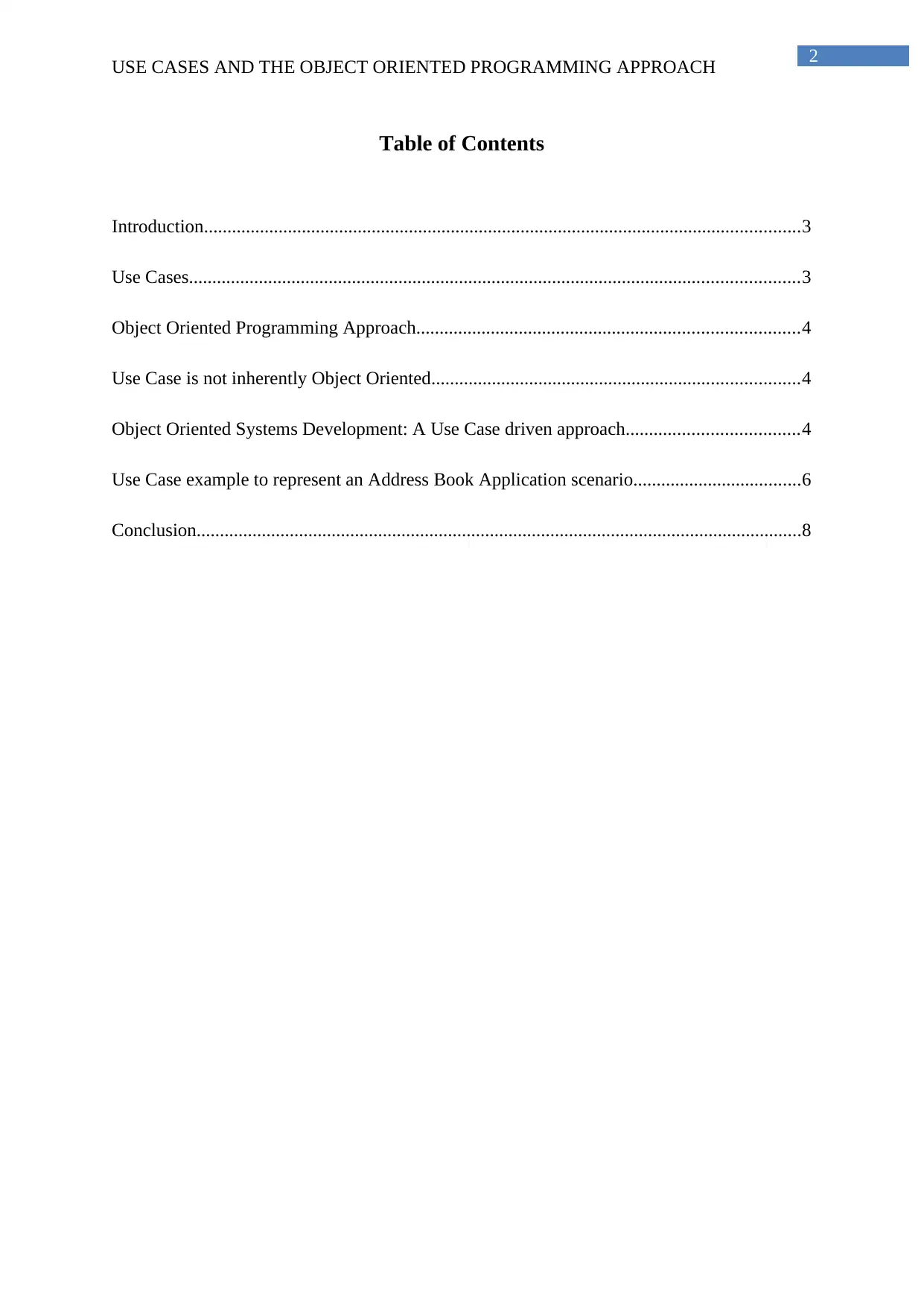
2
USE CASES AND THE OBJECT ORIENTED PROGRAMMING APPROACH
Table of Contents
Introduction................................................................................................................................3
Use Cases...................................................................................................................................3
Object Oriented Programming Approach..................................................................................4
Use Case is not inherently Object Oriented...............................................................................4
Object Oriented Systems Development: A Use Case driven approach.....................................4
Use Case example to represent an Address Book Application scenario....................................6
Conclusion..................................................................................................................................8
USE CASES AND THE OBJECT ORIENTED PROGRAMMING APPROACH
Table of Contents
Introduction................................................................................................................................3
Use Cases...................................................................................................................................3
Object Oriented Programming Approach..................................................................................4
Use Case is not inherently Object Oriented...............................................................................4
Object Oriented Systems Development: A Use Case driven approach.....................................4
Use Case example to represent an Address Book Application scenario....................................6
Conclusion..................................................................................................................................8
⊘ This is a preview!⊘
Do you want full access?
Subscribe today to unlock all pages.

Trusted by 1+ million students worldwide
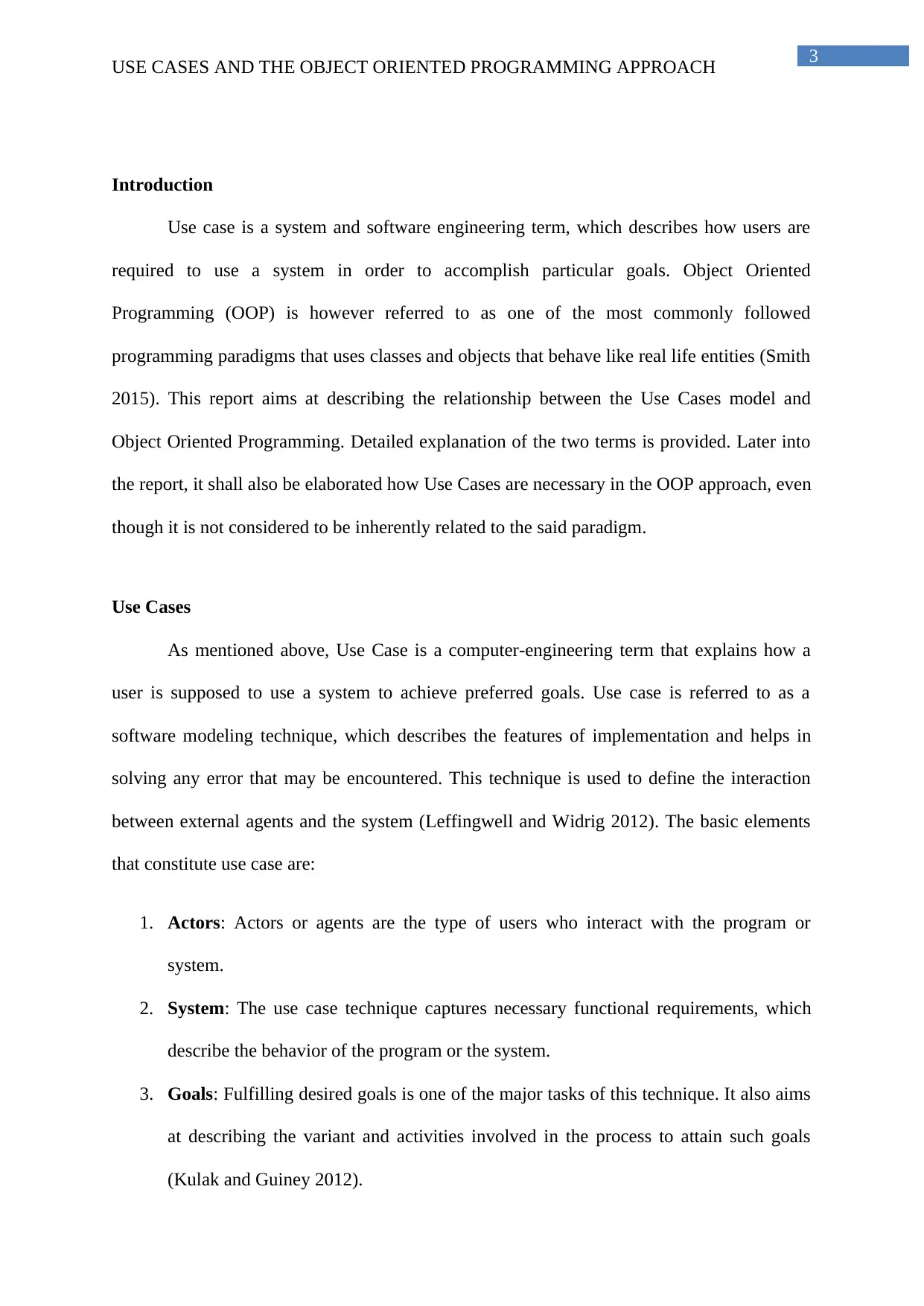
3
USE CASES AND THE OBJECT ORIENTED PROGRAMMING APPROACH
Introduction
Use case is a system and software engineering term, which describes how users are
required to use a system in order to accomplish particular goals. Object Oriented
Programming (OOP) is however referred to as one of the most commonly followed
programming paradigms that uses classes and objects that behave like real life entities (Smith
2015). This report aims at describing the relationship between the Use Cases model and
Object Oriented Programming. Detailed explanation of the two terms is provided. Later into
the report, it shall also be elaborated how Use Cases are necessary in the OOP approach, even
though it is not considered to be inherently related to the said paradigm.
Use Cases
As mentioned above, Use Case is a computer-engineering term that explains how a
user is supposed to use a system to achieve preferred goals. Use case is referred to as a
software modeling technique, which describes the features of implementation and helps in
solving any error that may be encountered. This technique is used to define the interaction
between external agents and the system (Leffingwell and Widrig 2012). The basic elements
that constitute use case are:
1. Actors: Actors or agents are the type of users who interact with the program or
system.
2. System: The use case technique captures necessary functional requirements, which
describe the behavior of the program or the system.
3. Goals: Fulfilling desired goals is one of the major tasks of this technique. It also aims
at describing the variant and activities involved in the process to attain such goals
(Kulak and Guiney 2012).
USE CASES AND THE OBJECT ORIENTED PROGRAMMING APPROACH
Introduction
Use case is a system and software engineering term, which describes how users are
required to use a system in order to accomplish particular goals. Object Oriented
Programming (OOP) is however referred to as one of the most commonly followed
programming paradigms that uses classes and objects that behave like real life entities (Smith
2015). This report aims at describing the relationship between the Use Cases model and
Object Oriented Programming. Detailed explanation of the two terms is provided. Later into
the report, it shall also be elaborated how Use Cases are necessary in the OOP approach, even
though it is not considered to be inherently related to the said paradigm.
Use Cases
As mentioned above, Use Case is a computer-engineering term that explains how a
user is supposed to use a system to achieve preferred goals. Use case is referred to as a
software modeling technique, which describes the features of implementation and helps in
solving any error that may be encountered. This technique is used to define the interaction
between external agents and the system (Leffingwell and Widrig 2012). The basic elements
that constitute use case are:
1. Actors: Actors or agents are the type of users who interact with the program or
system.
2. System: The use case technique captures necessary functional requirements, which
describe the behavior of the program or the system.
3. Goals: Fulfilling desired goals is one of the major tasks of this technique. It also aims
at describing the variant and activities involved in the process to attain such goals
(Kulak and Guiney 2012).
Paraphrase This Document
Need a fresh take? Get an instant paraphrase of this document with our AI Paraphraser
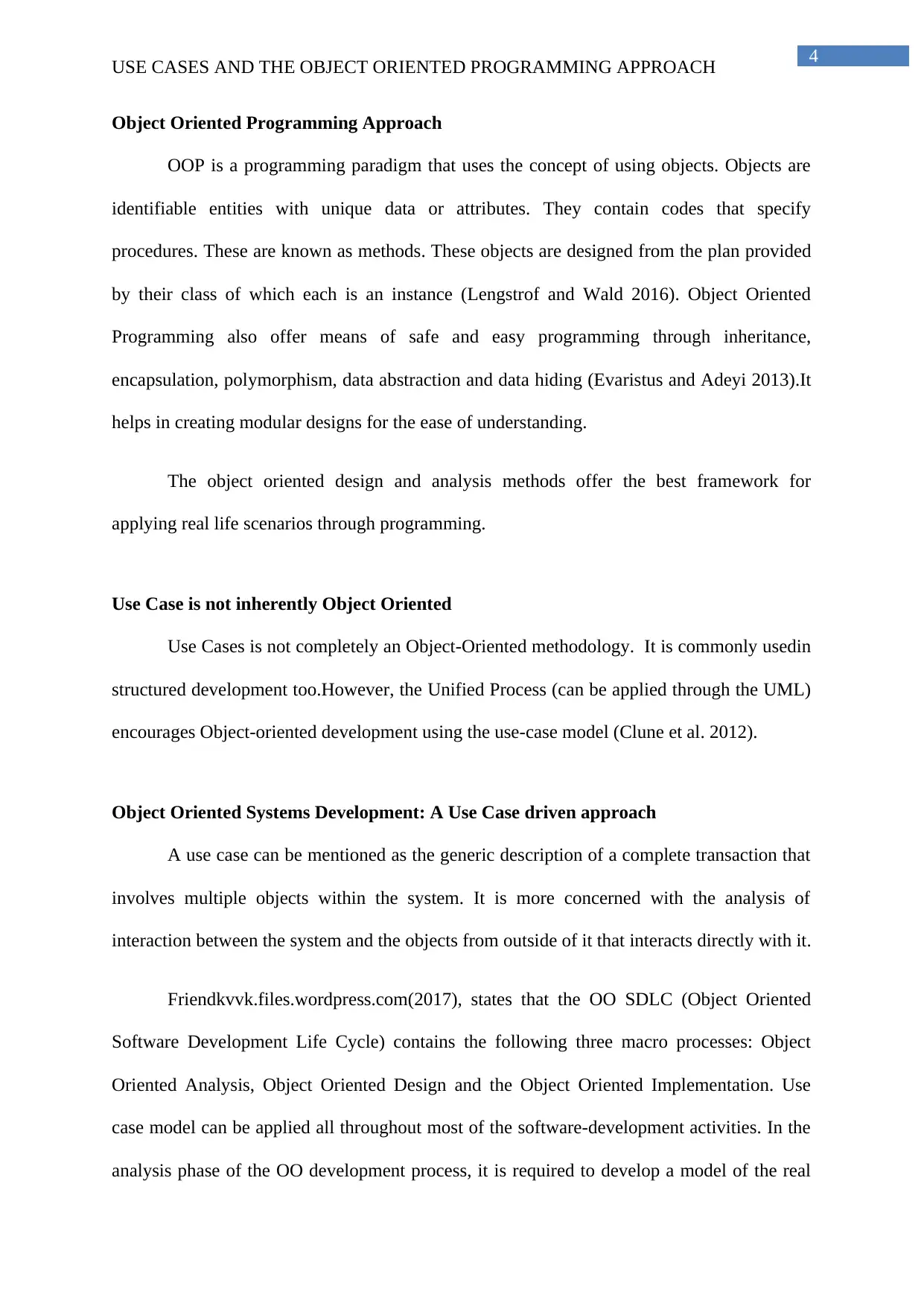
4
USE CASES AND THE OBJECT ORIENTED PROGRAMMING APPROACH
Object Oriented Programming Approach
OOP is a programming paradigm that uses the concept of using objects. Objects are
identifiable entities with unique data or attributes. They contain codes that specify
procedures. These are known as methods. These objects are designed from the plan provided
by their class of which each is an instance (Lengstrof and Wald 2016). Object Oriented
Programming also offer means of safe and easy programming through inheritance,
encapsulation, polymorphism, data abstraction and data hiding (Evaristus and Adeyi 2013).It
helps in creating modular designs for the ease of understanding.
The object oriented design and analysis methods offer the best framework for
applying real life scenarios through programming.
Use Case is not inherently Object Oriented
Use Cases is not completely an Object-Oriented methodology. It is commonly usedin
structured development too.However, the Unified Process (can be applied through the UML)
encourages Object-oriented development using the use-case model (Clune et al. 2012).
Object Oriented Systems Development: A Use Case driven approach
A use case can be mentioned as the generic description of a complete transaction that
involves multiple objects within the system. It is more concerned with the analysis of
interaction between the system and the objects from outside of it that interacts directly with it.
Friendkvvk.files.wordpress.com(2017), states that the OO SDLC (Object Oriented
Software Development Life Cycle) contains the following three macro processes: Object
Oriented Analysis, Object Oriented Design and the Object Oriented Implementation. Use
case model can be applied all throughout most of the software-development activities. In the
analysis phase of the OO development process, it is required to develop a model of the real
USE CASES AND THE OBJECT ORIENTED PROGRAMMING APPROACH
Object Oriented Programming Approach
OOP is a programming paradigm that uses the concept of using objects. Objects are
identifiable entities with unique data or attributes. They contain codes that specify
procedures. These are known as methods. These objects are designed from the plan provided
by their class of which each is an instance (Lengstrof and Wald 2016). Object Oriented
Programming also offer means of safe and easy programming through inheritance,
encapsulation, polymorphism, data abstraction and data hiding (Evaristus and Adeyi 2013).It
helps in creating modular designs for the ease of understanding.
The object oriented design and analysis methods offer the best framework for
applying real life scenarios through programming.
Use Case is not inherently Object Oriented
Use Cases is not completely an Object-Oriented methodology. It is commonly usedin
structured development too.However, the Unified Process (can be applied through the UML)
encourages Object-oriented development using the use-case model (Clune et al. 2012).
Object Oriented Systems Development: A Use Case driven approach
A use case can be mentioned as the generic description of a complete transaction that
involves multiple objects within the system. It is more concerned with the analysis of
interaction between the system and the objects from outside of it that interacts directly with it.
Friendkvvk.files.wordpress.com(2017), states that the OO SDLC (Object Oriented
Software Development Life Cycle) contains the following three macro processes: Object
Oriented Analysis, Object Oriented Design and the Object Oriented Implementation. Use
case model can be applied all throughout most of the software-development activities. In the
analysis phase of the OO development process, it is required to develop a model of the real
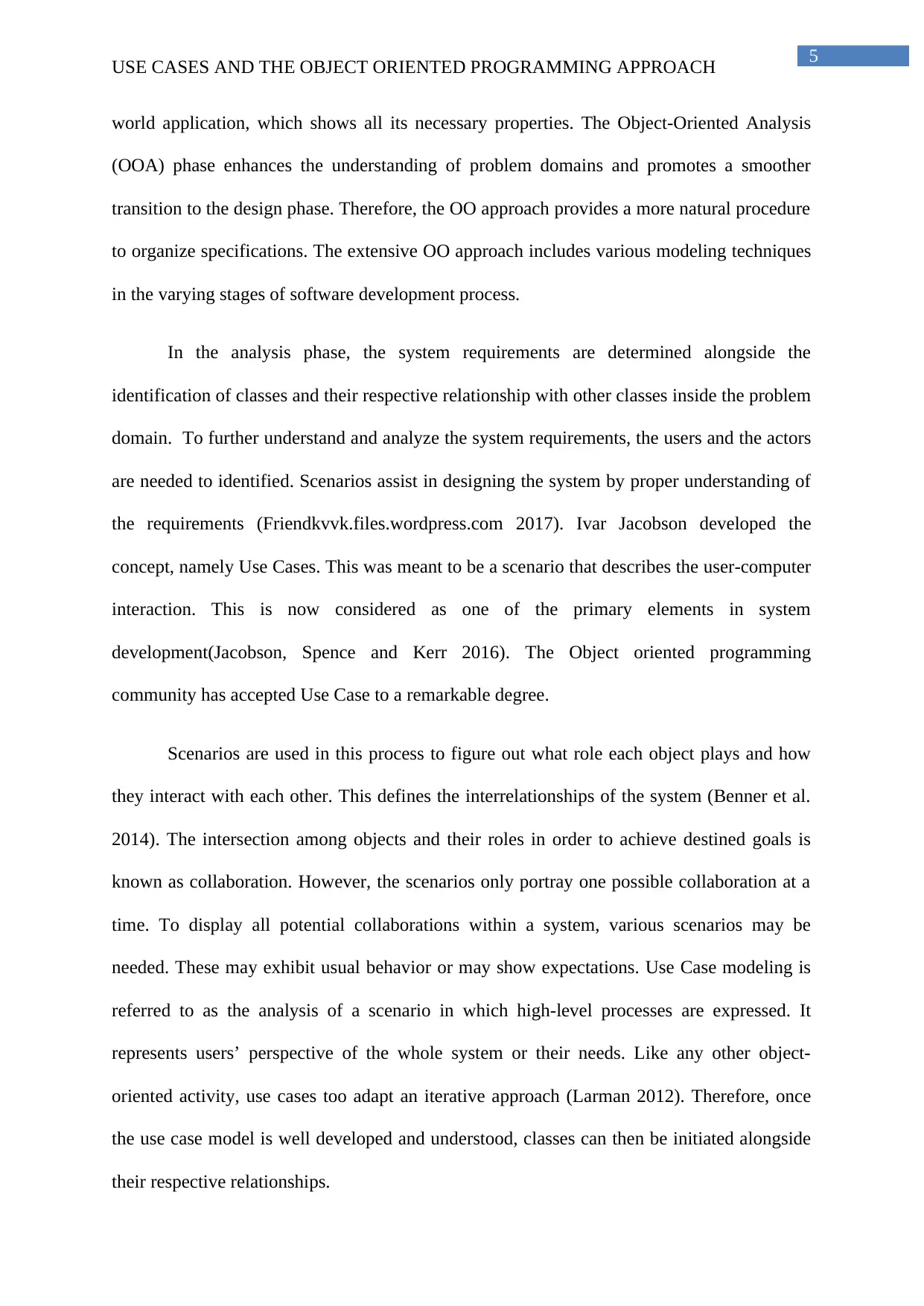
5
USE CASES AND THE OBJECT ORIENTED PROGRAMMING APPROACH
world application, which shows all its necessary properties. The Object-Oriented Analysis
(OOA) phase enhances the understanding of problem domains and promotes a smoother
transition to the design phase. Therefore, the OO approach provides a more natural procedure
to organize specifications. The extensive OO approach includes various modeling techniques
in the varying stages of software development process.
In the analysis phase, the system requirements are determined alongside the
identification of classes and their respective relationship with other classes inside the problem
domain. To further understand and analyze the system requirements, the users and the actors
are needed to identified. Scenarios assist in designing the system by proper understanding of
the requirements (Friendkvvk.files.wordpress.com 2017). Ivar Jacobson developed the
concept, namely Use Cases. This was meant to be a scenario that describes the user-computer
interaction. This is now considered as one of the primary elements in system
development(Jacobson, Spence and Kerr 2016). The Object oriented programming
community has accepted Use Case to a remarkable degree.
Scenarios are used in this process to figure out what role each object plays and how
they interact with each other. This defines the interrelationships of the system (Benner et al.
2014). The intersection among objects and their roles in order to achieve destined goals is
known as collaboration. However, the scenarios only portray one possible collaboration at a
time. To display all potential collaborations within a system, various scenarios may be
needed. These may exhibit usual behavior or may show expectations. Use Case modeling is
referred to as the analysis of a scenario in which high-level processes are expressed. It
represents users’ perspective of the whole system or their needs. Like any other object-
oriented activity, use cases too adapt an iterative approach (Larman 2012). Therefore, once
the use case model is well developed and understood, classes can then be initiated alongside
their respective relationships.
USE CASES AND THE OBJECT ORIENTED PROGRAMMING APPROACH
world application, which shows all its necessary properties. The Object-Oriented Analysis
(OOA) phase enhances the understanding of problem domains and promotes a smoother
transition to the design phase. Therefore, the OO approach provides a more natural procedure
to organize specifications. The extensive OO approach includes various modeling techniques
in the varying stages of software development process.
In the analysis phase, the system requirements are determined alongside the
identification of classes and their respective relationship with other classes inside the problem
domain. To further understand and analyze the system requirements, the users and the actors
are needed to identified. Scenarios assist in designing the system by proper understanding of
the requirements (Friendkvvk.files.wordpress.com 2017). Ivar Jacobson developed the
concept, namely Use Cases. This was meant to be a scenario that describes the user-computer
interaction. This is now considered as one of the primary elements in system
development(Jacobson, Spence and Kerr 2016). The Object oriented programming
community has accepted Use Case to a remarkable degree.
Scenarios are used in this process to figure out what role each object plays and how
they interact with each other. This defines the interrelationships of the system (Benner et al.
2014). The intersection among objects and their roles in order to achieve destined goals is
known as collaboration. However, the scenarios only portray one possible collaboration at a
time. To display all potential collaborations within a system, various scenarios may be
needed. These may exhibit usual behavior or may show expectations. Use Case modeling is
referred to as the analysis of a scenario in which high-level processes are expressed. It
represents users’ perspective of the whole system or their needs. Like any other object-
oriented activity, use cases too adapt an iterative approach (Larman 2012). Therefore, once
the use case model is well developed and understood, classes can then be initiated alongside
their respective relationships.
⊘ This is a preview!⊘
Do you want full access?
Subscribe today to unlock all pages.

Trusted by 1+ million students worldwide
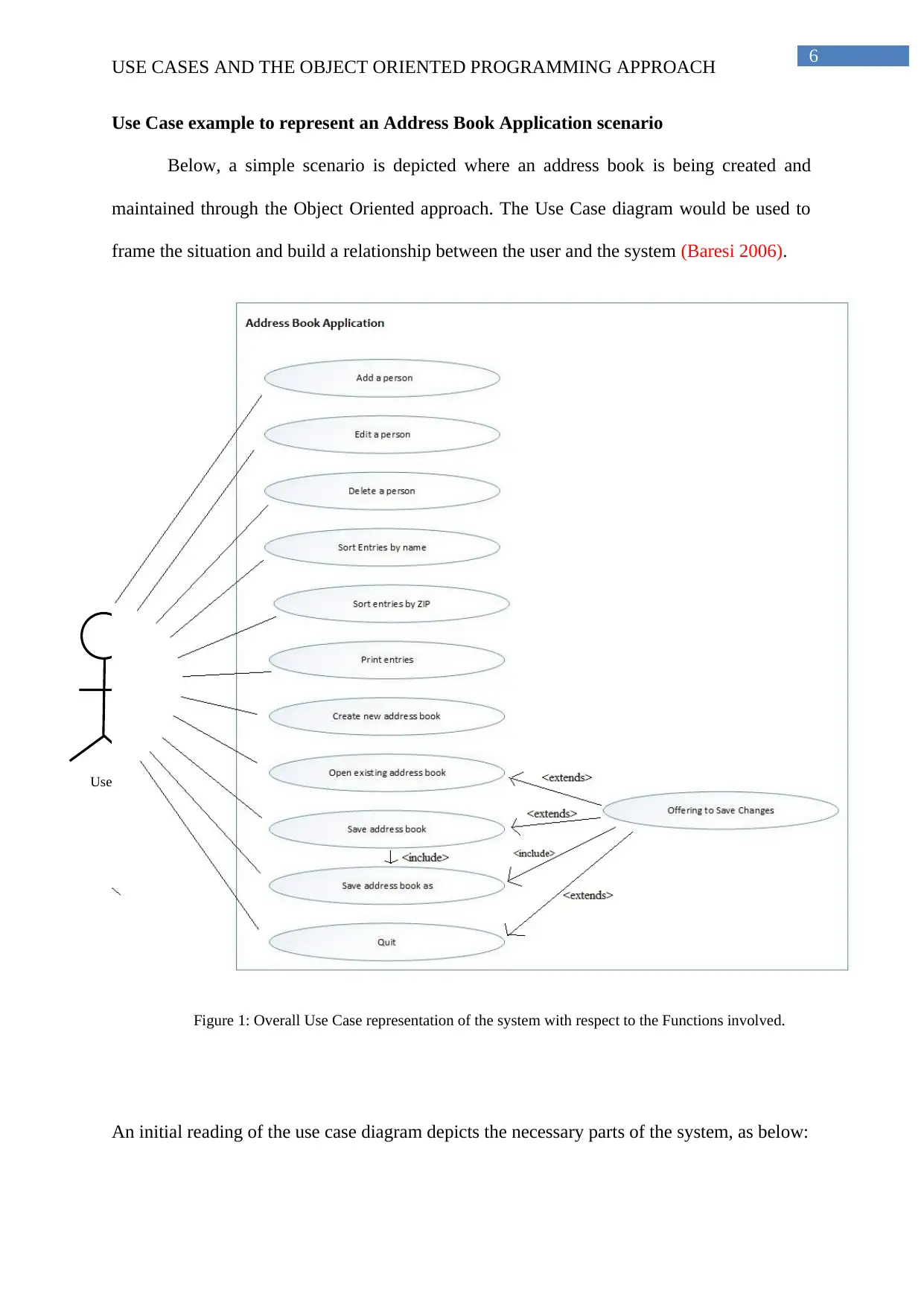
6
User
USE CASES AND THE OBJECT ORIENTED PROGRAMMING APPROACH
Use Case example to represent an Address Book Application scenario
Below, a simple scenario is depicted where an address book is being created and
maintained through the Object Oriented approach. The Use Case diagram would be used to
frame the situation and build a relationship between the user and the system (Baresi 2006).
Figure 1: Overall Use Case representation of the system with respect to the Functions involved.
An initial reading of the use case diagram depicts the necessary parts of the system, as below:
User
USE CASES AND THE OBJECT ORIENTED PROGRAMMING APPROACH
Use Case example to represent an Address Book Application scenario
Below, a simple scenario is depicted where an address book is being created and
maintained through the Object Oriented approach. The Use Case diagram would be used to
frame the situation and build a relationship between the user and the system (Baresi 2006).
Figure 1: Overall Use Case representation of the system with respect to the Functions involved.
An initial reading of the use case diagram depicts the necessary parts of the system, as below:
Paraphrase This Document
Need a fresh take? Get an instant paraphrase of this document with our AI Paraphraser
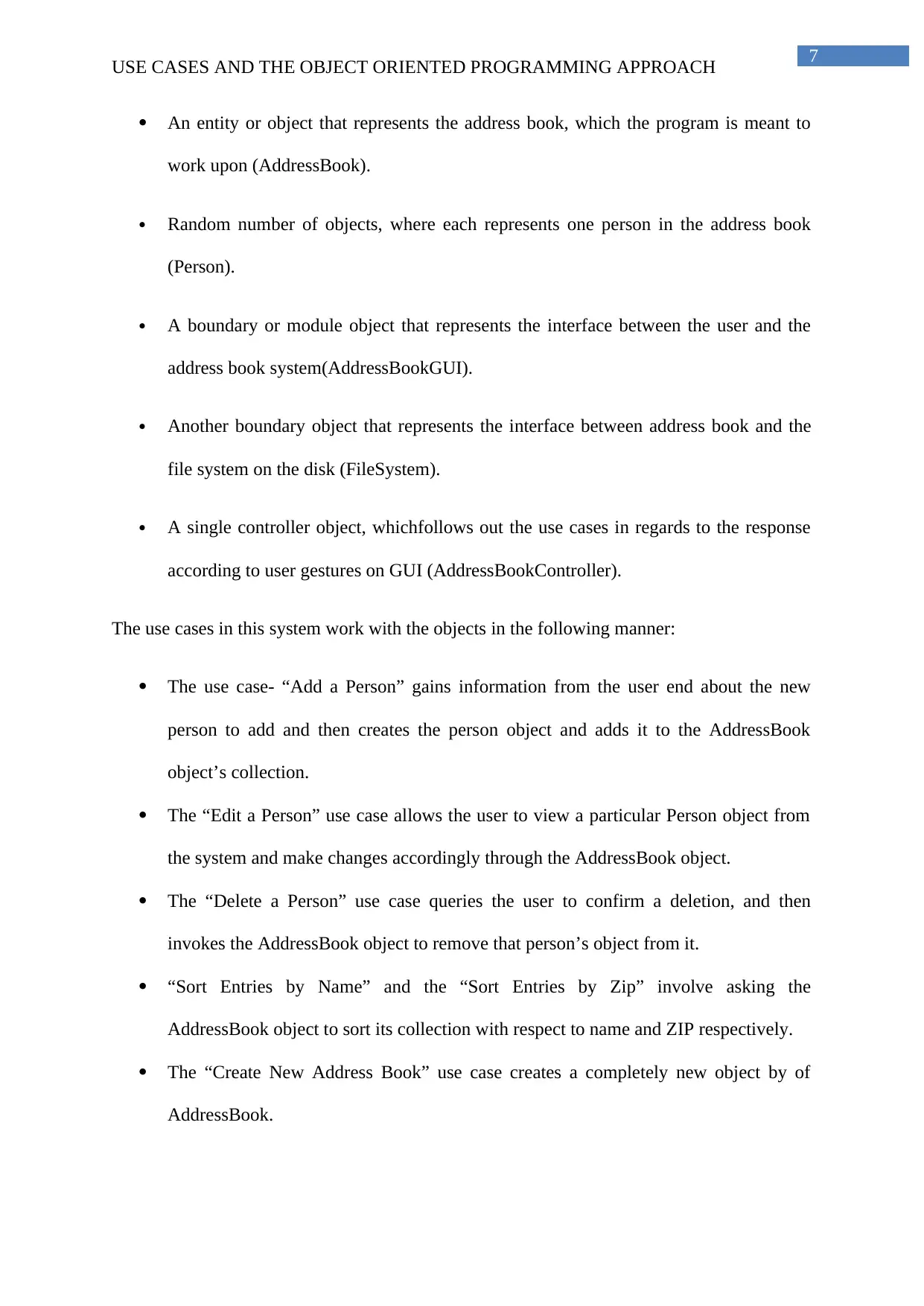
7
USE CASES AND THE OBJECT ORIENTED PROGRAMMING APPROACH
An entity or object that represents the address book, which the program is meant to
work upon (AddressBook).
Random number of objects, where each represents one person in the address book
(Person).
A boundary or module object that represents the interface between the user and the
address book system(AddressBookGUI).
Another boundary object that represents the interface between address book and the
file system on the disk (FileSystem).
A single controller object, whichfollows out the use cases in regards to the response
according to user gestures on GUI (AddressBookController).
The use cases in this system work with the objects in the following manner:
The use case- “Add a Person” gains information from the user end about the new
person to add and then creates the person object and adds it to the AddressBook
object’s collection.
The “Edit a Person” use case allows the user to view a particular Person object from
the system and make changes accordingly through the AddressBook object.
The “Delete a Person” use case queries the user to confirm a deletion, and then
invokes the AddressBook object to remove that person’s object from it.
“Sort Entries by Name” and the “Sort Entries by Zip” involve asking the
AddressBook object to sort its collection with respect to name and ZIP respectively.
The “Create New Address Book” use case creates a completely new object by of
AddressBook.
USE CASES AND THE OBJECT ORIENTED PROGRAMMING APPROACH
An entity or object that represents the address book, which the program is meant to
work upon (AddressBook).
Random number of objects, where each represents one person in the address book
(Person).
A boundary or module object that represents the interface between the user and the
address book system(AddressBookGUI).
Another boundary object that represents the interface between address book and the
file system on the disk (FileSystem).
A single controller object, whichfollows out the use cases in regards to the response
according to user gestures on GUI (AddressBookController).
The use cases in this system work with the objects in the following manner:
The use case- “Add a Person” gains information from the user end about the new
person to add and then creates the person object and adds it to the AddressBook
object’s collection.
The “Edit a Person” use case allows the user to view a particular Person object from
the system and make changes accordingly through the AddressBook object.
The “Delete a Person” use case queries the user to confirm a deletion, and then
invokes the AddressBook object to remove that person’s object from it.
“Sort Entries by Name” and the “Sort Entries by Zip” involve asking the
AddressBook object to sort its collection with respect to name and ZIP respectively.
The “Create New Address Book” use case creates a completely new object by of
AddressBook.
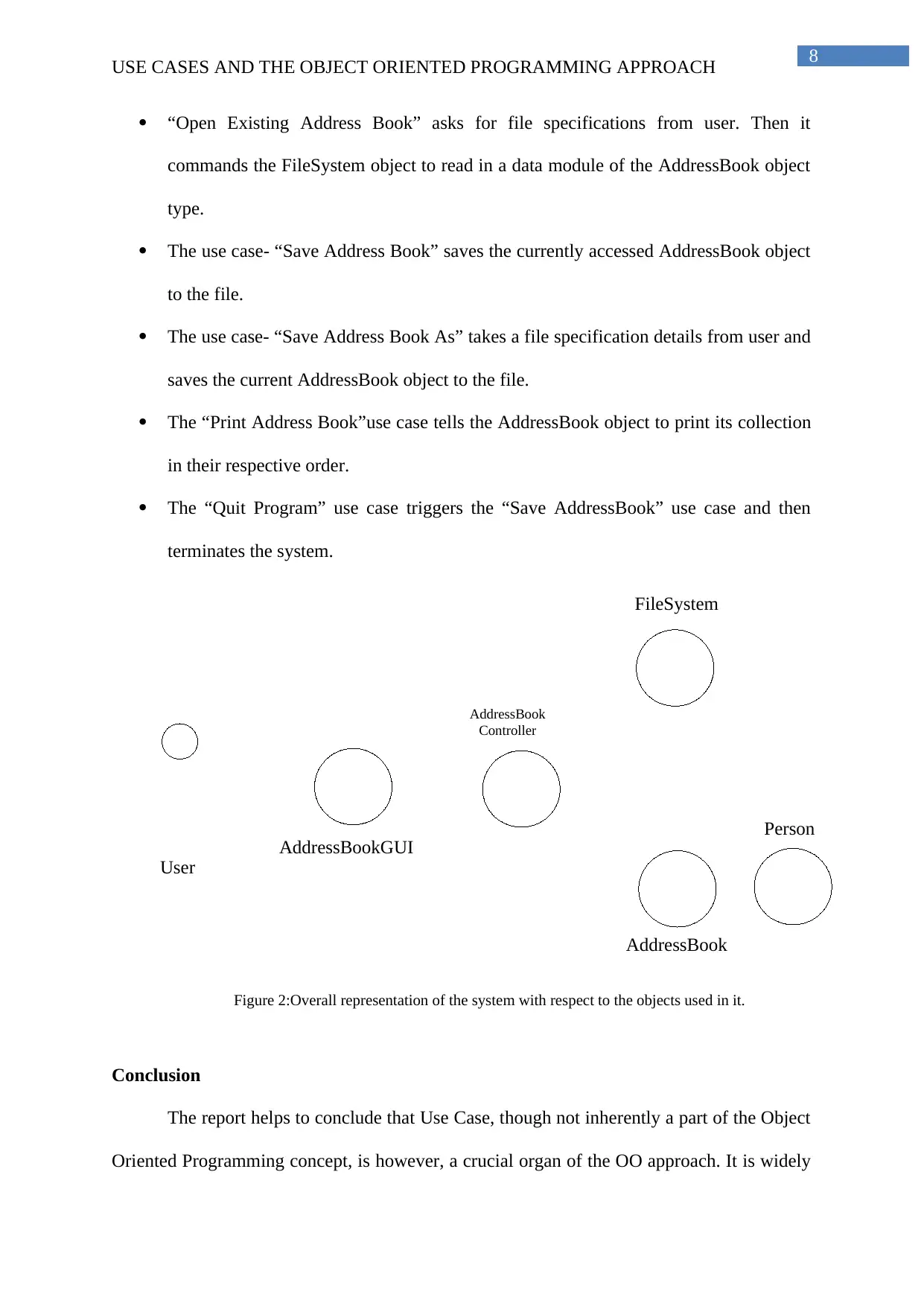
8
User
AddressBookGUI
AddressBook
Controller
FileSystem
AddressBook
Person
USE CASES AND THE OBJECT ORIENTED PROGRAMMING APPROACH
“Open Existing Address Book” asks for file specifications from user. Then it
commands the FileSystem object to read in a data module of the AddressBook object
type.
The use case- “Save Address Book” saves the currently accessed AddressBook object
to the file.
The use case- “Save Address Book As” takes a file specification details from user and
saves the current AddressBook object to the file.
The “Print Address Book”use case tells the AddressBook object to print its collection
in their respective order.
The “Quit Program” use case triggers the “Save AddressBook” use case and then
terminates the system.
Figure 2:Overall representation of the system with respect to the objects used in it.
Conclusion
The report helps to conclude that Use Case, though not inherently a part of the Object
Oriented Programming concept, is however, a crucial organ of the OO approach. It is widely
User
AddressBookGUI
AddressBook
Controller
FileSystem
AddressBook
Person
USE CASES AND THE OBJECT ORIENTED PROGRAMMING APPROACH
“Open Existing Address Book” asks for file specifications from user. Then it
commands the FileSystem object to read in a data module of the AddressBook object
type.
The use case- “Save Address Book” saves the currently accessed AddressBook object
to the file.
The use case- “Save Address Book As” takes a file specification details from user and
saves the current AddressBook object to the file.
The “Print Address Book”use case tells the AddressBook object to print its collection
in their respective order.
The “Quit Program” use case triggers the “Save AddressBook” use case and then
terminates the system.
Figure 2:Overall representation of the system with respect to the objects used in it.
Conclusion
The report helps to conclude that Use Case, though not inherently a part of the Object
Oriented Programming concept, is however, a crucial organ of the OO approach. It is widely
⊘ This is a preview!⊘
Do you want full access?
Subscribe today to unlock all pages.

Trusted by 1+ million students worldwide
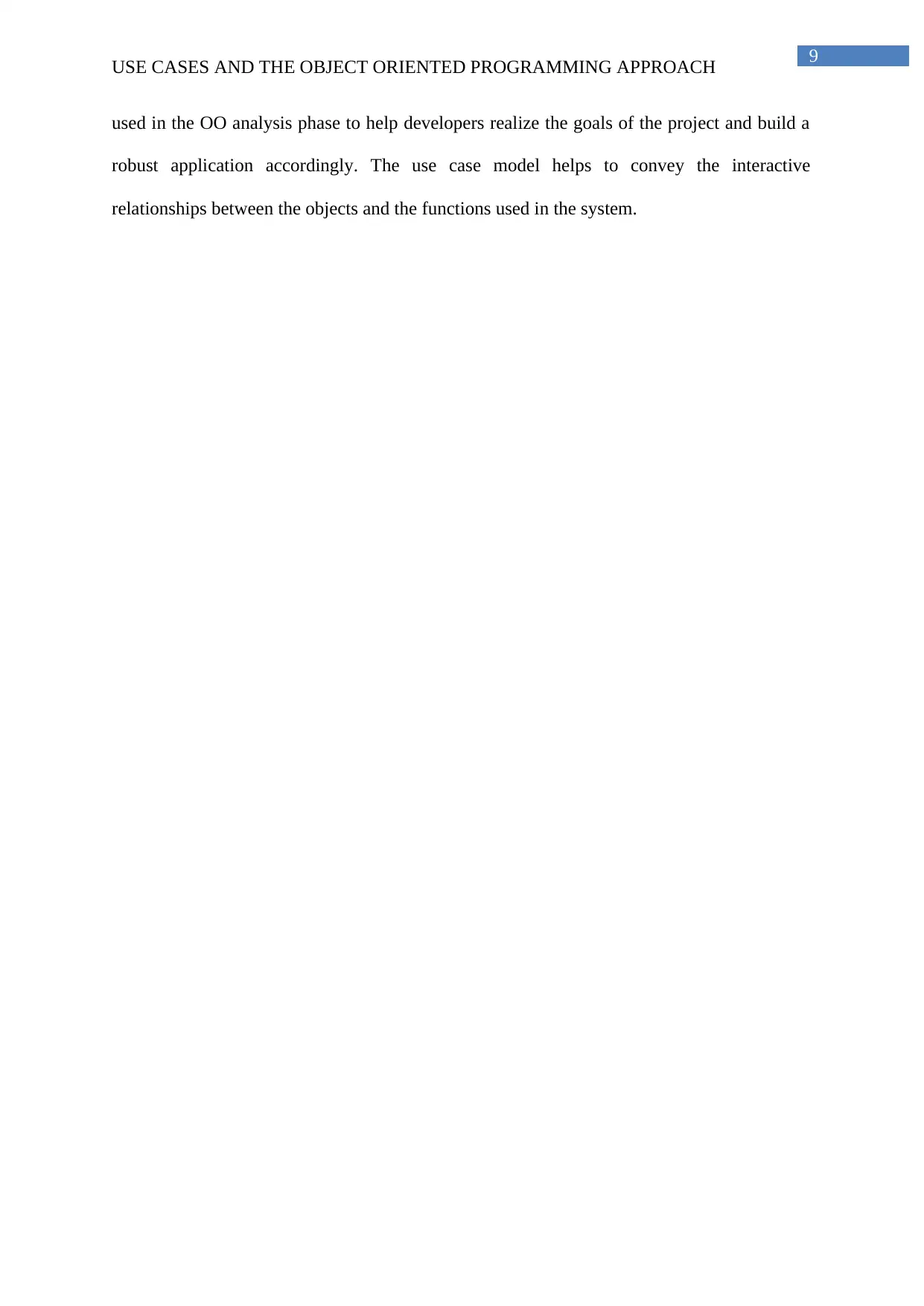
9
USE CASES AND THE OBJECT ORIENTED PROGRAMMING APPROACH
used in the OO analysis phase to help developers realize the goals of the project and build a
robust application accordingly. The use case model helps to convey the interactive
relationships between the objects and the functions used in the system.
USE CASES AND THE OBJECT ORIENTED PROGRAMMING APPROACH
used in the OO analysis phase to help developers realize the goals of the project and build a
robust application accordingly. The use case model helps to convey the interactive
relationships between the objects and the functions used in the system.
Paraphrase This Document
Need a fresh take? Get an instant paraphrase of this document with our AI Paraphraser
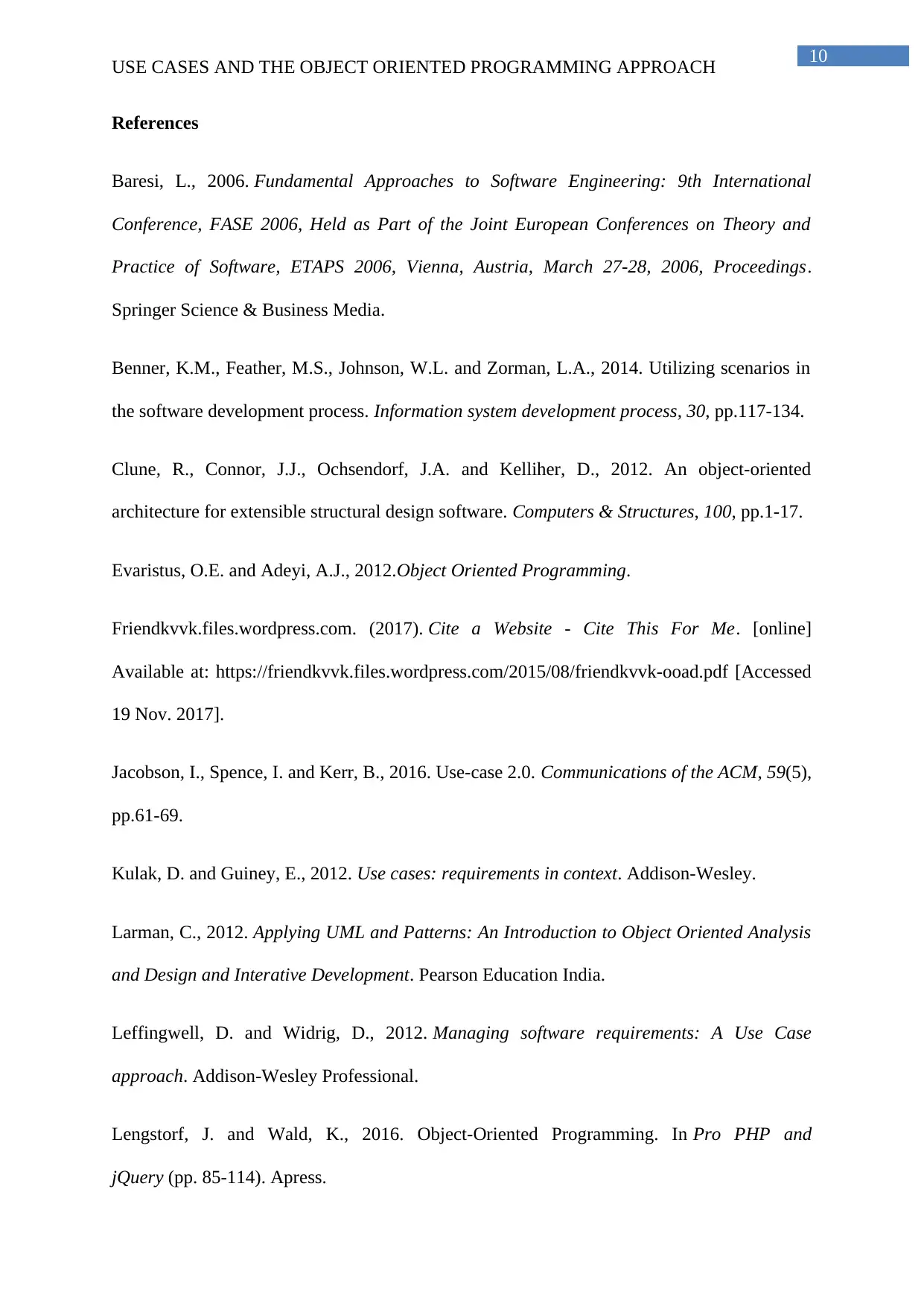
10
USE CASES AND THE OBJECT ORIENTED PROGRAMMING APPROACH
References
Baresi, L., 2006. Fundamental Approaches to Software Engineering: 9th International
Conference, FASE 2006, Held as Part of the Joint European Conferences on Theory and
Practice of Software, ETAPS 2006, Vienna, Austria, March 27-28, 2006, Proceedings.
Springer Science & Business Media.
Benner, K.M., Feather, M.S., Johnson, W.L. and Zorman, L.A., 2014. Utilizing scenarios in
the software development process. Information system development process, 30, pp.117-134.
Clune, R., Connor, J.J., Ochsendorf, J.A. and Kelliher, D., 2012. An object-oriented
architecture for extensible structural design software. Computers & Structures, 100, pp.1-17.
Evaristus, O.E. and Adeyi, A.J., 2012.Object Oriented Programming.
Friendkvvk.files.wordpress.com. (2017). Cite a Website - Cite This For Me. [online]
Available at: https://friendkvvk.files.wordpress.com/2015/08/friendkvvk-ooad.pdf [Accessed
19 Nov. 2017].
Jacobson, I., Spence, I. and Kerr, B., 2016. Use-case 2.0. Communications of the ACM, 59(5),
pp.61-69.
Kulak, D. and Guiney, E., 2012. Use cases: requirements in context. Addison-Wesley.
Larman, C., 2012. Applying UML and Patterns: An Introduction to Object Oriented Analysis
and Design and Interative Development. Pearson Education India.
Leffingwell, D. and Widrig, D., 2012. Managing software requirements: A Use Case
approach. Addison-Wesley Professional.
Lengstorf, J. and Wald, K., 2016. Object-Oriented Programming. In Pro PHP and
jQuery (pp. 85-114). Apress.
USE CASES AND THE OBJECT ORIENTED PROGRAMMING APPROACH
References
Baresi, L., 2006. Fundamental Approaches to Software Engineering: 9th International
Conference, FASE 2006, Held as Part of the Joint European Conferences on Theory and
Practice of Software, ETAPS 2006, Vienna, Austria, March 27-28, 2006, Proceedings.
Springer Science & Business Media.
Benner, K.M., Feather, M.S., Johnson, W.L. and Zorman, L.A., 2014. Utilizing scenarios in
the software development process. Information system development process, 30, pp.117-134.
Clune, R., Connor, J.J., Ochsendorf, J.A. and Kelliher, D., 2012. An object-oriented
architecture for extensible structural design software. Computers & Structures, 100, pp.1-17.
Evaristus, O.E. and Adeyi, A.J., 2012.Object Oriented Programming.
Friendkvvk.files.wordpress.com. (2017). Cite a Website - Cite This For Me. [online]
Available at: https://friendkvvk.files.wordpress.com/2015/08/friendkvvk-ooad.pdf [Accessed
19 Nov. 2017].
Jacobson, I., Spence, I. and Kerr, B., 2016. Use-case 2.0. Communications of the ACM, 59(5),
pp.61-69.
Kulak, D. and Guiney, E., 2012. Use cases: requirements in context. Addison-Wesley.
Larman, C., 2012. Applying UML and Patterns: An Introduction to Object Oriented Analysis
and Design and Interative Development. Pearson Education India.
Leffingwell, D. and Widrig, D., 2012. Managing software requirements: A Use Case
approach. Addison-Wesley Professional.
Lengstorf, J. and Wald, K., 2016. Object-Oriented Programming. In Pro PHP and
jQuery (pp. 85-114). Apress.

11
USE CASES AND THE OBJECT ORIENTED PROGRAMMING APPROACH
Smith, B., 2015. Object-oriented programming. In Advanced ActionScript 3 (pp. 1-23).
Apress.
USE CASES AND THE OBJECT ORIENTED PROGRAMMING APPROACH
Smith, B., 2015. Object-oriented programming. In Advanced ActionScript 3 (pp. 1-23).
Apress.
⊘ This is a preview!⊘
Do you want full access?
Subscribe today to unlock all pages.

Trusted by 1+ million students worldwide
1 out of 12
Related Documents
Your All-in-One AI-Powered Toolkit for Academic Success.
+13062052269
info@desklib.com
Available 24*7 on WhatsApp / Email
![[object Object]](/_next/static/media/star-bottom.7253800d.svg)
Unlock your academic potential
Copyright © 2020–2025 A2Z Services. All Rights Reserved. Developed and managed by ZUCOL.




